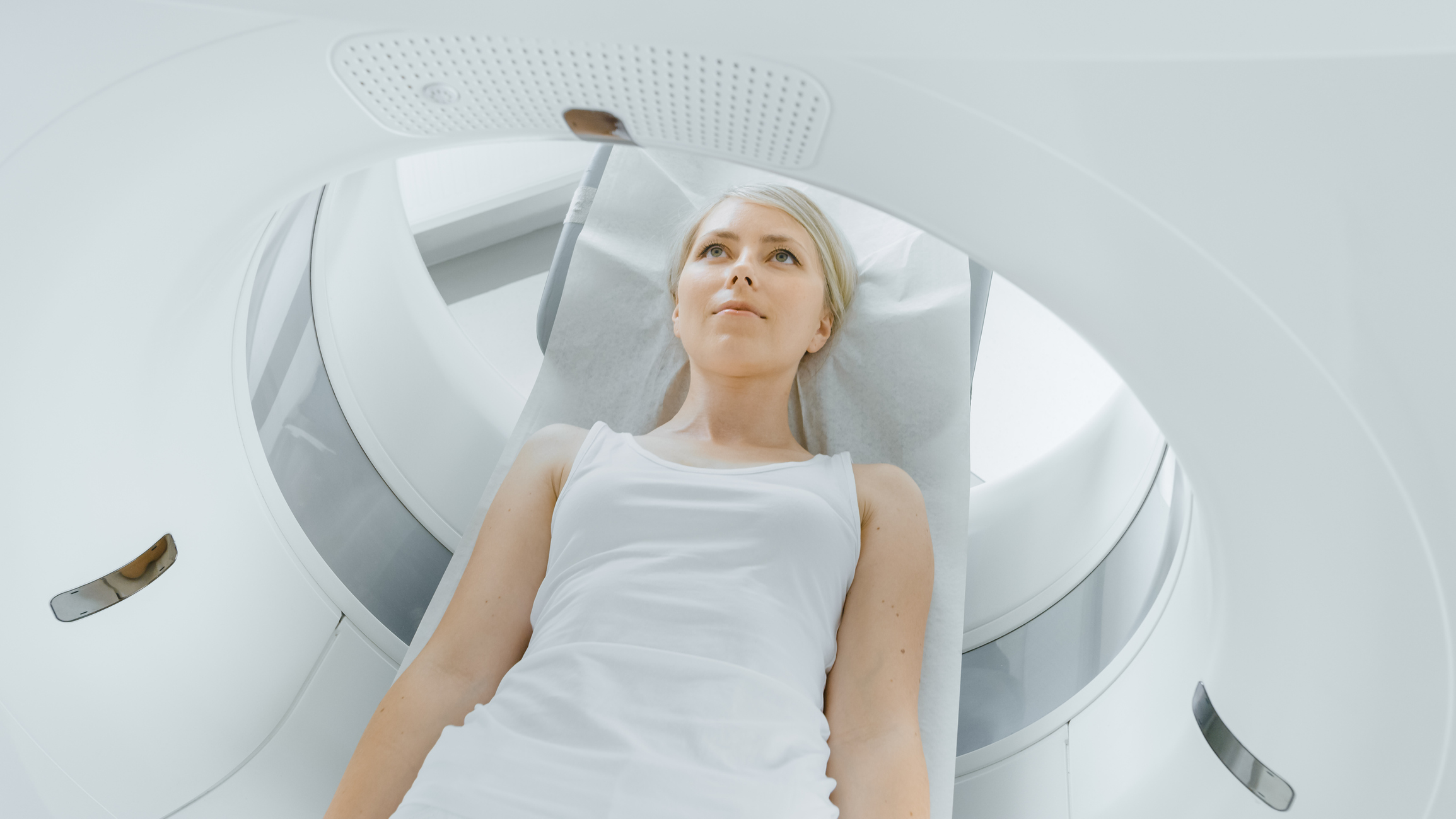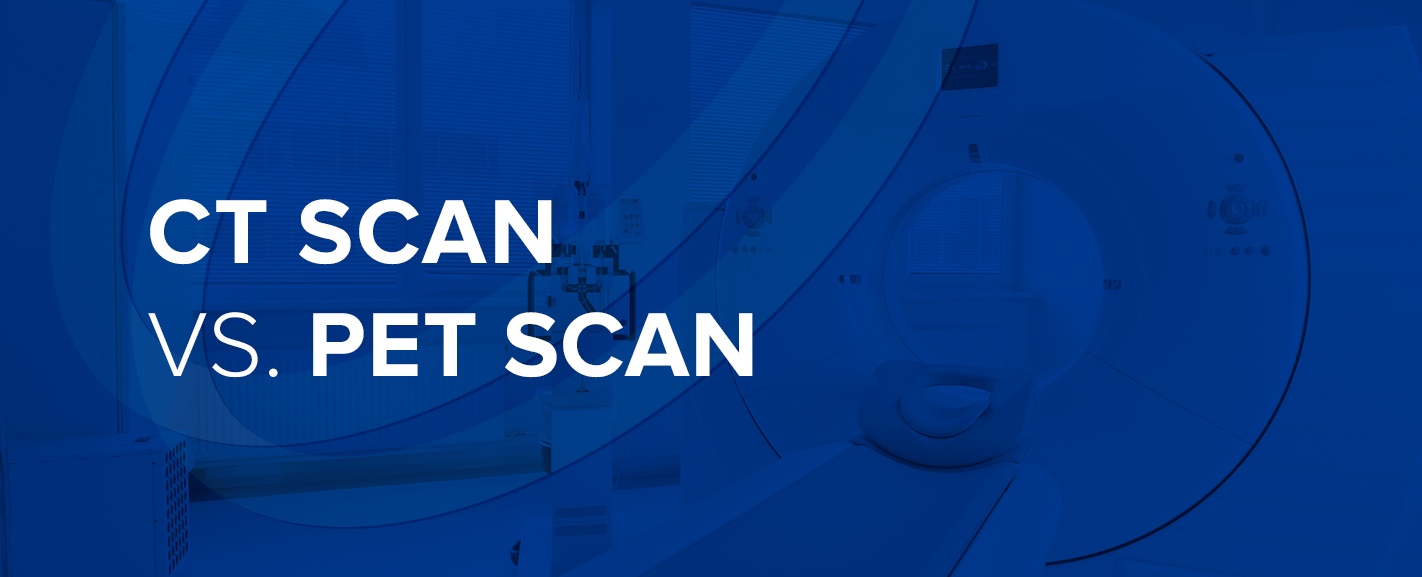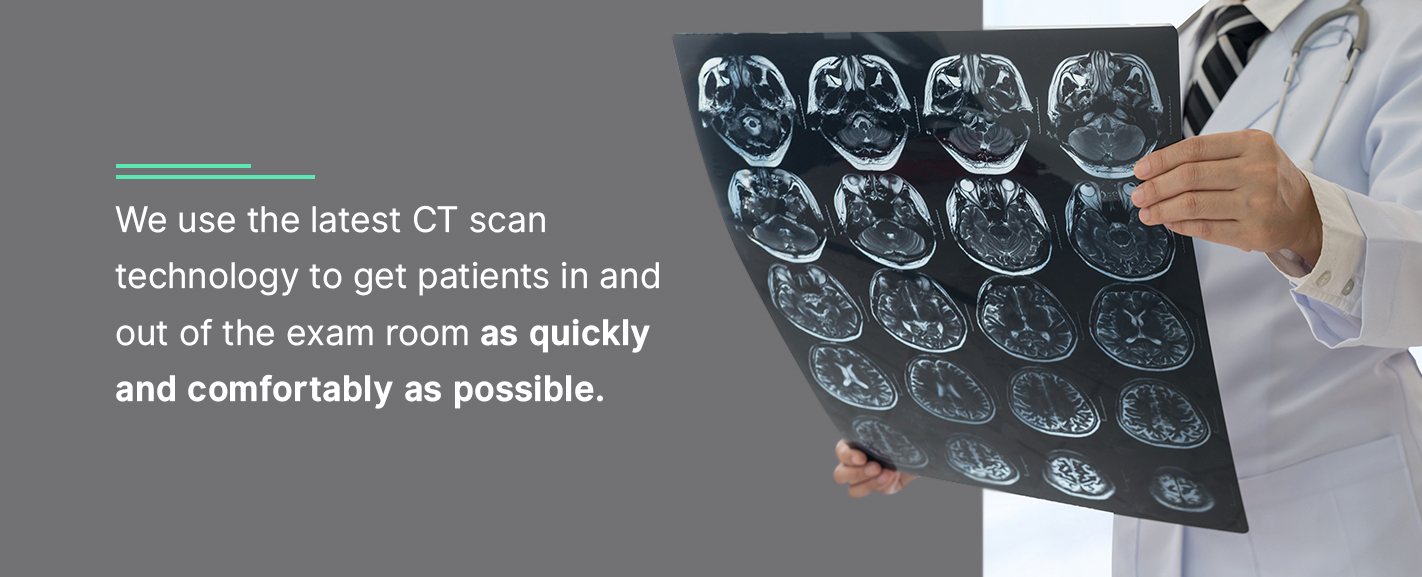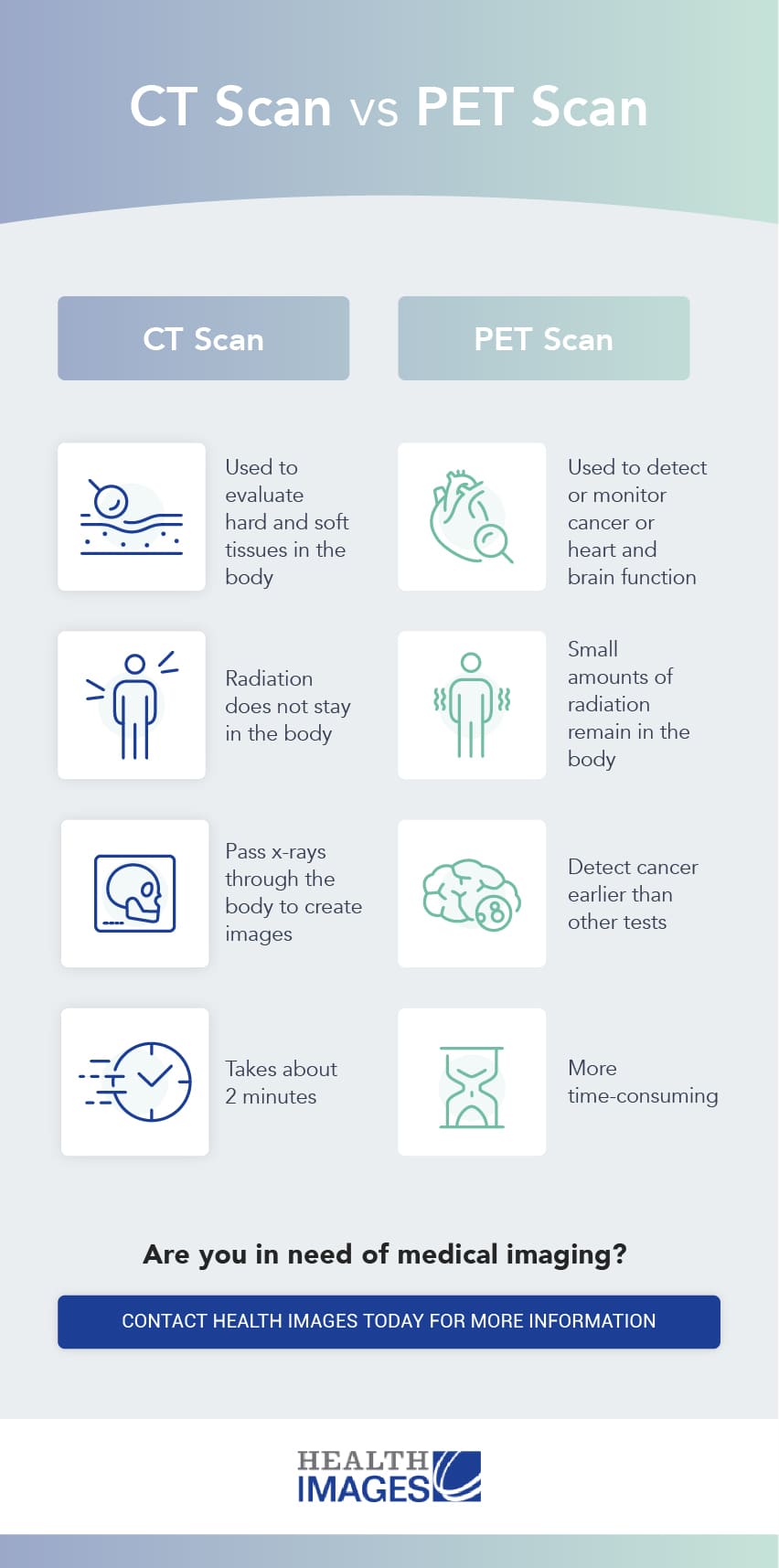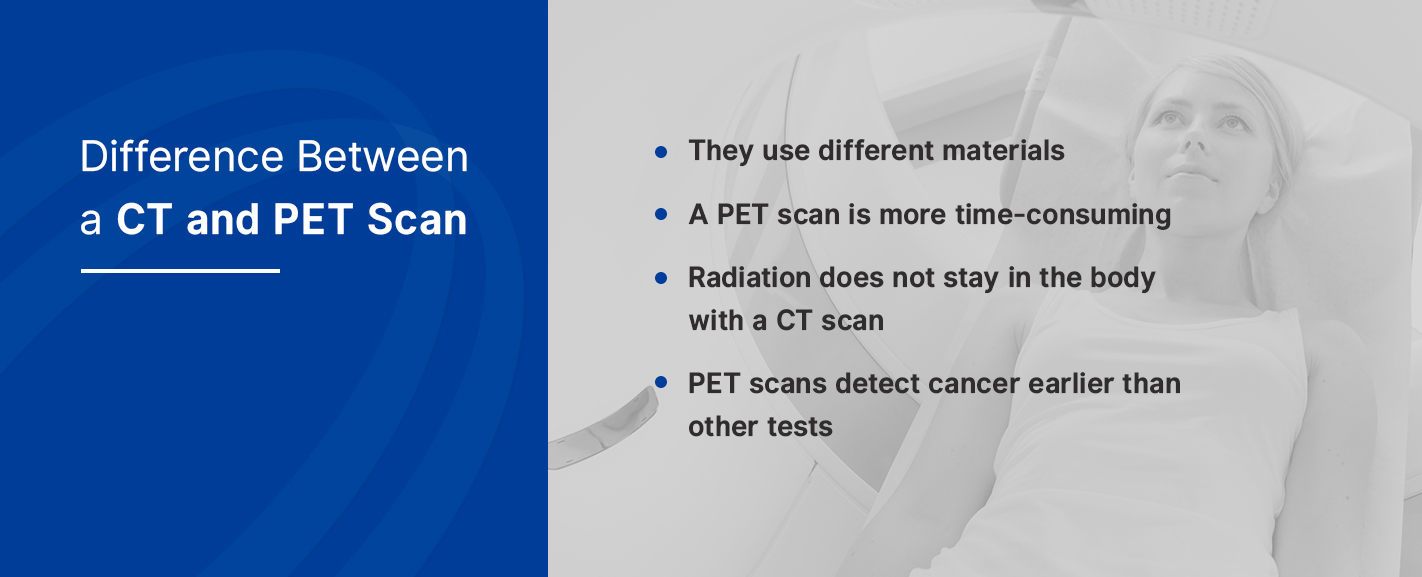CT Scan vs. PET Scan
Millions of Americans undergo imaging tests every year to help doctors diagnose a health condition. For example, according to Harvard Medical School, over 80 million CT scans are performed each year. Imaging procedures provide a window to the interior human body without the need for an incision. This helps keep patients out of the operating room and saves them the risks and costs of surgery. Imaging tests also help doctors make quick decisions so they can treat patients right away.
The purpose of most imaging tests is to help doctors detect or monitor an injury or disease. Two commonly ordered tests are CT scans and PET scans, but they are not the same. We’ll explore how these tests work, why they’re used, and the similarities and differences between PET and CT Scans.
Jump to Sections:
- What Is a CT Scan?
- How Does a CT Scan Work?
- What Is a PET Scan?
- How Does a PET Scan Work?
- What Is the Difference Between a CT and PET Scan?
- How Are PET and CT Scans Similar?
What Is a CT Scan?
A computed tomography (CT) scan is a special type of imaging procedure. A CT scan produces a detailed 3-D image of the inside of your body. This type of scan is often prescribed to check for abnormalities in the brain, spine, neck, chest or abdomen. By looking at CT scan images, your doctor can evaluate hard tissues, such as your bones, and soft tissues, such as your muscles and organs. This means a CT scan will show everything from a bone fracture to a tumor.
CT scans are common procedures in hospitals and imaging centers because they allow doctors to make critical medical decisions fast. They are especially helpful tools to check for life-threatening conditions quickly. For example, patients who were in a car accident may undergo a CT scan after they’re taken to a hospital. This allows a doctor to check for organ injuries, bone fractures and internal bleeding.
How Does a CT Scan Work?
You might think of a CT scan as a much more detailed x-ray. A CT scan machine uses multiple x-ray beams to capture images of the body from different angles. This information translates to cross-sectional pictures, or “slices,” on a computer monitor.
To undergo the procedure, a patient will usually lie flat on an exam table. The table will then move through the CT scan machine as it takes images. The scanning process usually takes a few minutes. Some patients may need to ingest a contrast material before the scan, either by drinking the substance or receiving it intravenously. The contrast is a dye that highlights the areas being examined so doctors can see them more clearly.
Although CT scans are a simple, painless procedure, technologists aim to perform the scan quickly. At Health Images, we use the latest CT scan technology to get patients in and out of the exam room as quickly and comfortably as possible.
What Is a PET Scan?
A positron emission tomography (PET) scan is a form of nuclear medicine imaging. A PET scan uses a tiny amount of radioactive material called a radiotracer, a camera and a computer to create images of the inside of your body. A PET scan shows a doctor how your tissues and organs work.
PET scans are most commonly used to detect or monitor cancer. Doctors might also use a PET scan to assess heart and brain functioning.
How Does a PET Scan Work?
During a PET scan procedure, a technologist will inject a small amount of the radioactive tracer into a patient’s vein, usually on the inside of an elbow. After the injection, the tracer will move through the body and gather in tissues and organs. A patient will need to wait for about an hour for their body to absorb the tracer. Tracers will collect in tumors, inflamed areas or cancer cells for doctors to see.
After the tracer is absorbed, the patient will move to an exam table that slides into a scanner. The PET scanner will detect the tracer and turn the data into 3-D images on a computer monitor. Some imaging centers combine PET scans with CT scans to create specialized images.
PET Scan Compared to a CT Scan
PET scans and CT scans are both critical diagnostic tools that provide clear, accurate views into the body. Although they share many similarities, they are also both very different types of imaging. Let’s look at how the two compare.
What Is the Difference Between a CT and PET Scan?
Perhaps the main difference between a CT scan and a PET scan is their focus. A CT scan creates a detailed non-moving image of organs, bones and tissues. A PET scan, on the other hand, shows doctors how the tissues in your body work on a cellular level. Other differences include:
- They use different materials: CT scans pass x-rays through the body to create images. A PET scan uses a radioactive material which emits energy. The energy is then detected by a special camera to produce images.
- A PET scan is more time-consuming: A CT scan is performed in minutes. This makes it an excellent tool in emergency situations when doctors need to act fast. A PET scan could take 20 minutes to several hours, depending on a patient’s condition. In some cases, the procedure may be performed over several days.
- Radiation does not stay in the body with a CT scan: After a CT scan, no radiation remains in the body. On the contrary, a small amount of radiation may stay in the body for a short time after a PET scan.
- PET scans detect cancer earlier than other tests: Unlike other forms of imaging, a PET scan shows molecular activity and helps doctors identify diseases in the earliest stages. For this reason, a PET scan is a highly reliable tool for detecting cancer. CT scans show signs of an issue after a disease begins to change the structure of tissues or organs.
How Are PET and CT Scans Similar?
CT scans and PET scans focus on different aspects of the human body and use unique materials to do so, but they still share a lot in common. Similarities between CT scans and PET scans include:
- Both are usually performed at an outpatient facility and do not require a hospital stay.
- Both can be used to detect cancer.
- Both are accurate, painless and noninvasive procedures.
- Both help eliminate the need for exploratory surgery.
Most importantly, both types of imaging tests help doctors diagnose the cause of a patient’s symptoms. This allows doctors to effectively treat their patients and help them enjoy healthy lives.
Schedule Your Appointment Today
Whether your doctor has ordered a CT scan or a PET scan, you may feel a little anxious about the procedure. Any medical imaging exam can cause worrisome feelings before and after the test. At Health Images, our team of dedicated, compassionate technologists want to make the experience as pleasant and stress-free as possible.
We have the latest technology and technologists who care, so you can depend on us to meet your imaging needs. To learn more about our services or schedule an appointment, contact a Health Images center today.
Call To Schedule Your Appointment
Sources
- https://www.independentimaging.com/ct-scans-vs-pet-scans/
- https://www.ctoam.com/services/testing/imaging/pet-ct-scan/pet-ct-scan-vs-ct/
- https://medlineplus.gov/ctscans.html
- https://www.healthimages.com/services/ct-scans/
- https://www.radiologyinfo.org/en/info.cfm?pg=abdominct
- https://www.mayoclinic.org/tests-procedures/ct-scan/about/pac-20393675
- https://www.radiologyinfo.org/en/info.cfm?pg=pet
- https://www.radiologyinfo.org/en/info.cfm?pg=gennuclear
- https://medlineplus.gov/ency/article/003827.htm
- https://www.mayo.edu/research/documents/radiation-exposure-during-imaging-examspdf/DOC-10027821
- https://my.clevelandclinic.org/health/diagnostics/10123-pet-scan
- https://www.healthimages.com/locations/
- https://www.health.harvard.edu/cancer/radiation-risk-from-medical-imaging
- https://www.healthimages.com/about-us/

